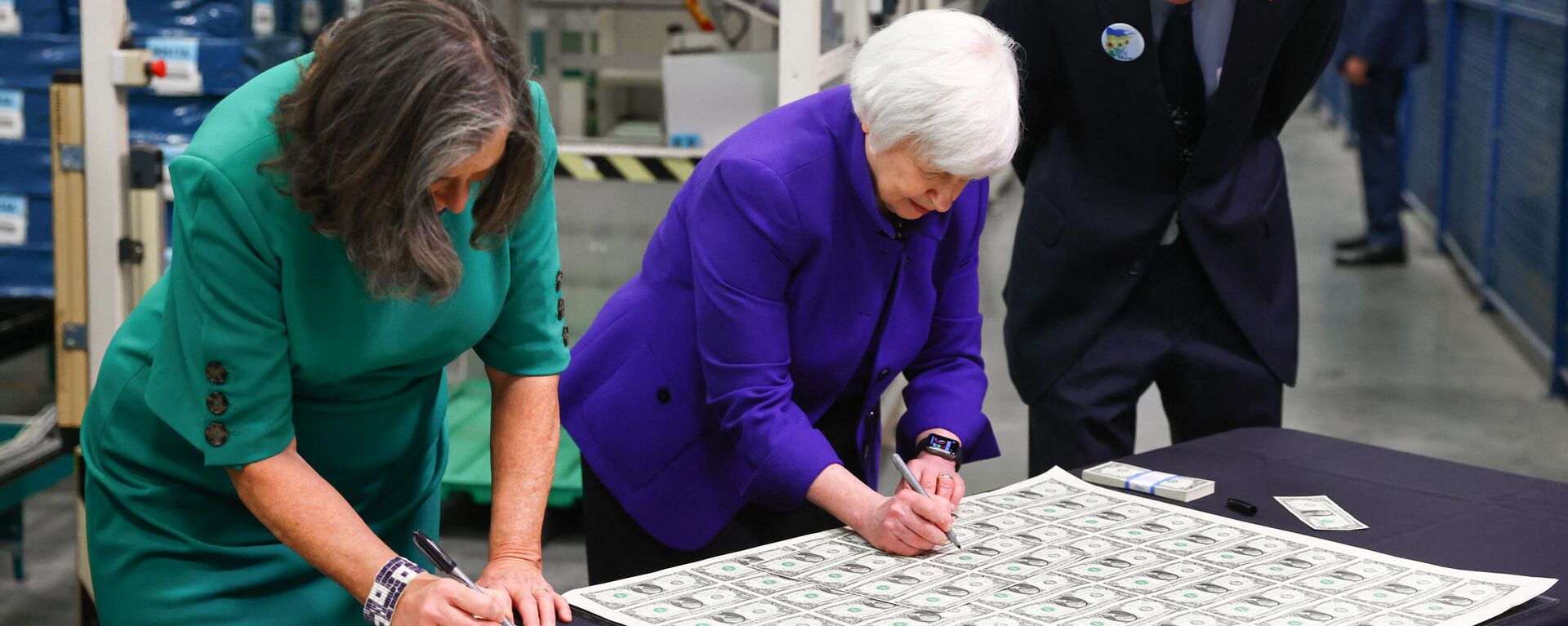https://sputnikglobe.com/20230414/us-needs-more-rate-hikes-as-fight-against-inflation-not-over-federal-reserve-governor-says-1109538868.html
US Needs More Rate Hikes as Fight Against Inflation Not Over, Federal Reserve Governor Says
US Needs More Rate Hikes as Fight Against Inflation Not Over, Federal Reserve Governor Says
Sputnik International
Federal Reserve Governor Waller, one of the US central bank’s biggest hawks for higher interest rates, wants more monetary tightening in the US despite evidence that inflation is coming off four-decade highs.
2023-04-14T18:20+0000
2023-04-14T18:20+0000
2023-04-14T18:20+0000
economy
economy
us economy
us federal reserve
banking
rate hike
https://cdn1.img.sputnikglobe.com/img/07e5/0b/1d/1091122895_0:0:3295:1853_1920x0_80_0_0_32fd162debfeef26ea1fdc8d873910c7.jpg
A rash of recent US economic data from consumer to wholesale prices as well as retail sales show the Fed making progress in its fight against virtually unrestrained price hikes. Yet, Waller pointed at a stronger-than-expected labor market and relatively-high wages as reasons for the central bank to stay on the path of higher rates that it has been on since March 2020. US wholesale prices fell the most in nearly three years last month while consumer prices grew about one percent below February levels in March, even as core prices minus food and energy remained stubbornly higher, according to Labor Department data from this week. While it is still early to anticipate what the central bank will do regarding the interest rates during its meeting in May, some economists are pricing in another hike of 25 basis points based on the jobs growth for March. Others have said they think the Fed might actually call for a pause after the Consumer Price Index (CPI) expanded at an annual rate of just 5% in March versus February’s 6%. In June, the so-called CPI was up 9.1% on the year, hitting a four-decade high. The Fed’s target for inflation is 2% per year. Waller ruled out any likelihood of the Fed taking its foot off the interest rate hike pedal. Waller also said unyielding labor market growth was an indication that "we haven’t made much progress on our inflation goal, which leaves me at about the same place on the economic outlook." The Fed has a particularly delicate job in trying to balance job growth with inflation. Both are top priorities for the central bank, which is mandated with ensuring "maximum employment" through a jobless rate of 4% or below and keeping inflation manageable - a mission it easily achieved before the coronavirus pandemic measures were implemented, when prices expanded less than 2% a year.
https://sputnikglobe.com/20230413/us-budget-deficit-balloons-by-11-trillion-is-americas-massive-debt-bubble-about-to-burst-1109480226.html
Sputnik International
feedback@sputniknews.com
+74956456601
MIA „Rossiya Segodnya“
2023
Sputnik International
feedback@sputniknews.com
+74956456601
MIA „Rossiya Segodnya“
News
en_EN
Sputnik International
feedback@sputniknews.com
+74956456601
MIA „Rossiya Segodnya“
Sputnik International
feedback@sputniknews.com
+74956456601
MIA „Rossiya Segodnya“
economy, us economy, us federal reserve, banking, rate hike
economy, us economy, us federal reserve, banking, rate hike
US Needs More Rate Hikes as Fight Against Inflation Not Over, Federal Reserve Governor Says
WASHINGTON (Sputnik) - Federal Reserve Governor Christopher Waller, one of the US central bank’s biggest hawks for higher interest rates, said on Friday that he wants more monetary tightening in the United States despite evidence that inflation is coming off four-decade highs.
A rash of recent US economic data from consumer to wholesale prices as well as retail sales show the Fed making progress in its fight against virtually unrestrained price hikes. Yet, Waller pointed at a stronger-than-expected labor market and relatively-high wages as reasons for the central bank to stay on the path of higher rates that it has been on since March 2020.
"Because financial conditions have not significantly tightened, the labor market continues to be strong and quite tight, and inflation is far above target, so monetary policy needs to be tightened further," Waller said on Friday.
US wholesale prices fell the most in nearly three years last month while
consumer prices grew about one percent below February levels in March, even as core prices minus food and energy remained stubbornly higher, according to Labor Department data from this week.
The Fed has raised US interest rates by 475 basis points over the past 13 months to fight inflation, taking them to a peak of 5% from 0.25% after the COVID-19 outbreak in March 2020.
While it is still early to anticipate what the central bank
will do regarding the interest rates during its meeting in May, some economists are pricing in another hike of 25 basis points based on the jobs growth for March.
Others have said they think the Fed might actually call for a pause after the Consumer Price Index (CPI) expanded at an annual rate of just 5% in March versus February’s 6%. In June, the so-called CPI was up 9.1% on the year, hitting a four-decade high. The Fed’s target for inflation is 2% per year.
Waller ruled out any likelihood of the Fed taking its foot off the interest rate hike pedal.
"I would welcome signs of moderating demand, but until they appear and I see inflation moving meaningfully and persistently down toward our 2% target, I believe there is still work to do," he said.
Waller also said unyielding labor market growth was an indication that "we haven’t made much progress on our inflation goal, which leaves me at about the same place on the economic outlook."
The Fed has a particularly delicate job in trying to balance job growth with inflation. Both are top priorities for the central bank, which is mandated with ensuring "maximum employment" through a jobless rate of 4% or below and keeping inflation manageable - a
mission it easily achieved before the coronavirus pandemic measures were implemented, when prices expanded less than 2% a year.



